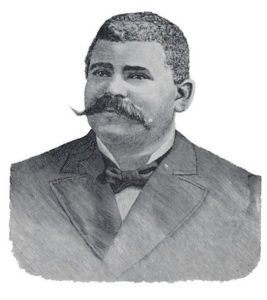
Rev. William J. Simmons
*William J. Simmons was born on this date in 1849. He was an educator, minister, and college administrator.
William J. Simmons was born a slave in Charleston, South Carolina, to Edward and Esther Simmons. While William was young, his mother fled slavery with her three children, William and his two sisters, Emeline and Anna. They initially came to Philadelphia, PA, and were met by an uncle named Alexander Tardiff, who provided them with housing, food, and education for their children. Due to the pressures from slave traders, Tardiff relocated his extended family to Roxbury, Pennsylvania, and Chester, Pennsylvania, and ultimately settled in Bordentown, New Jersey.
From 1862 to 1864, young Simmons was an apprentice to a dentist. He served in the Union Army during the American Civil War, enlisting on September 15, 1864, and serving a one-year term. He participated in the siege of Petersburg, the Battle of Hatcher's Run, and the Battle of Appomattox Courthouse, and was present at the surrender of Confederate General Robert E. Lee. After the war, he returned to his practice as a dentist. In 1867, he converted to Baptist and joined a white Baptist church in Bordentown that Reverend J. W. Custis pastored. The congregation helped him through college.
He attended Madison University (now Colgate University), Rochester University, and Howard University, from which he graduated with a bachelor's degree in 1873. As a student, he worked briefly in Washington, D.C., at Hillsdale School. In Hillsdale, he boarded with Smithsonian Institution employee Solomon G. Brown. After graduating, he moved to Arkansas on the advice of Horace Greeley to become a teacher there but returned to Hillsdale soon after, where he taught until June 1874.
That summer, he married Josephine A. Silence on August 25, 1874, and moved to Ocala, Florida. The couple had seven children: Josephine Lavinia, William Johnson, Maud Marie, Amanda Moss, Mary Beatrice, John Thomas, and Gussie Lewis. In Florida, he invested in land to grow oranges, became the principal of Howard Academy's teacher training program, and served as the pastor of a church, deputy county clerk, and county commissioner. He campaigned for the Republican Rutherford B. Hayes.
He served there until 1879. That year, he was ordained and moved to Lexington, Kentucky, where he served as pastor of the First Baptist Church. The following year, he became the second president of the Kentucky Normal and Theological Institute, where he worked for a decade. The school was eventually renamed the State University of Louisville due to its progress under his tenure, which led to its separation from Simmons College of Kentucky. In Kentucky, he was elected chairman of the State Convention of Colored Men for several years.
On September 29, 1882, he was elected editor of The American Baptist, where he criticized the failures of both political parties to support African Americans in their pursuit of civil rights and progress. He was also president of the American Baptist Company. In 1886, he was elected president of the Colored Press Association. In 1883, Simmons organized the Baptist Women's Educational Convention, and in 1884, Blanche Bruce appointed Simmons commissioner for the state of Kentucky at the 1884 World's Fair in New Orleans. In 1886, he organized and was elected president of the American National Baptist Convention.
The convention, led by Richard DeBaptiste, was a call for Black Baptist unity and featured notable presentations. In 1889, in Indianapolis, Simmons was a leader at the American National Baptist Convention and wrote a resolution to provide aid for Blacks fleeing violence in the South and moving to the North. Simmons received an honorary master's degree from Howard University in 1881 and an honorary Doctorate from Wilberforce University in 1885.
In 1887, he published a book entitled Men of Mark: Eminent, Progressive, and Rising, which highlights the lives of 172 prominent black men while serving as the school's president. He was working on a sister edition of the title that would highlight the lives and accomplishments of prominent pre-1900 Black women, but unfortunately, he died before its completion. He died on October 30, 1890, in Louisville, Kentucky.